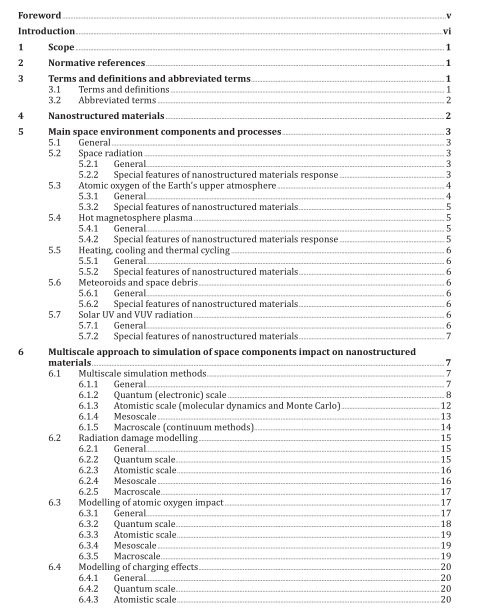ISO TS 22295:2021 pdf download.Space environment (natural and artificial) — Modelling of space environment impact on nanostructured materials — General principles
4 Nanostructured materials
The peculiar properties of nanomaterials are determined by the presence in their structure of nanoobjects – particles or grains, fibres, platelets, etc. with at least one linear dimension in nanoscale (size range from approximately 1 nm to 100 nm) [1]–[5] . The lower boundary of this range approaches the size of atoms and molecules; and its upper one separates nanoobjects from microobjects. The strong influence of the material nanostructure on its properties is caused by the so-called nanometre length scale effects which can be of classical and quantum nature.
The nanoscale effects appear when the size of structural objects becomes comparable with a certain parameter of material which has a considerable influence on some physical-chemical processes in the matter and consequently on the material properties [1],[2] .
A mean free path of charged particles, a diffusion length, etc. may be regarded as such a parameter in the case of classical length scale effects; and for quantum ones its role is usually played by the de Broglie wavelength. Another parameter of nanostructures is called dimensionality; it corresponds to the number of dimensions that lie within the nanometre range, and is used for analysing the quantum confinement effects [1],[2] . According to this parameter, all objects may be divided into four groups:
— 3D-objects – bulk materials;
—2D-objects – nanofilms, nanoplatlets;
— 1D-objects – nanofibres, nanotubes, nanorods, etc.;
— 0D-objects – nanoparticles, nanopores, nanocrystals, quantum dots, etc. In a 3D-object, electrons can move freely in all three dimensions.
In a film whose width is comparable with the de Broglie wavelength (2D-object), electrons move without restrictions only in the film plane, but in the perpendicular direction they are in a deep potential well; that’s why 2D-objects are usually called quantum well. In 1D-objects, or quantum wires, two dimensions are comparable with the de Broglie wavelength. If the electron movement is limited in three directions, a nanostructure becomes a 0D-object, or a quantum dot with discrete electronic states. Due to nanosized scale effects, nanostructured materials acquire novel mechanical, thermal, electrical, magnetic and optic properties, which can surpass the properties of conventional bulk materials [1],[2],[6],[7] . Nanocomposites with nanoclays, nanotubes and various nanoparticles as fillers are one of the most promising materials for space applications. They may be used as light-weighted and strong structural materials as well as multi-functional and smart materials of general and specific applications, e.g. thermal stabilization, radiation shielding, electrostatic charge mitigation, protection of atomic oxygen influence and space debris impact [8] .
Therefore, the creation of polymer nanocomposites with fillers of various shape and composition may play the pivotal role in spacecraft development and implementation of challenging space projects. Among possible fillers, the main attention is paid to carbon nanostructures: fullerenes, carbon nanotubes (CNT), graphene that represent particular allotropic forms of carbon [6],[7] . Due to superior mechanical properties, high electric and thermal conductivity of these nanostructures, one may develop various light-weighted and strong multifunctional nanocomposites. Of special interest are CNT structural analogues, boron nitride nanotubes (BNNTs), that are electrical insulators and in addition to excellent mechanical properties and high thermal stability possess high resistivity to oxidation [9],[10] . 5 Main space environment components and processes
5.1 General The space environment has a significant damaging effect on many materials, including nanostructured materials. During the flight, the spacecraft is influenced by a set of space environment components: electrons and high-energy ions, cold and hot space plasma, solar electromagnetic radiation, meteoroids and space debris, vacuum and other factors [11]–[18] . As a result of this impact, various physical and chemical processes take place in the materials and elements of the spacecraft equipment, leading to deterioration of their operational parameters. Depending on the nature of the processes triggered by the impact of the space environment, the changes in the properties of materials and equipment elements can have different time scales, be reversible or irreversible, and present a different degree of danger for on-board systems. To evaluate the potential effects of the space environment on material properties and the characteristics of spacecraft equipment, it is important to determine the combinations of the most significant factors in various areas of outer space. In this case it should be regarded as effects caused by the impact of individual components of the space environment, and their combined effect [12] .ISO TS 22295 pdf download.ISO TS 22295 pdf download.
